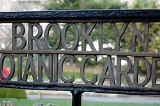
Brooklyn Botanic Garden
Encyclopedia
Brooklyn Botanic Garden (BBG) is a botanical garden
in the borough
of Brooklyn
in New York City
. Located near the Prospect Heights
, Crown Heights
, and Park Slope
neighborhoods, the 52 acres (21 ha) garden includes a number of specialty "gardens within the Garden," plant collections, and the Steinhardt Conservatory, which houses the C.V. Starr Bonsai Museum, three climate-themed plant pavilions, a white cast-iron
and glass aquatic plant
house, and an art gallery
. Founded in 1910, the Garden holds over 10,000 taxa of plants and each year welcomes over 900,000 visitors from around the world.
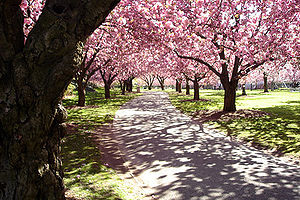 The Garden has more than 200 cherry
The Garden has more than 200 cherry
trees of forty-two Asia
n species and cultivated varieties, making it one of the foremost cherry-viewing sites outside of Japan
. The first cherries were planted at the garden after World War I, a gift from the Japanese government. Each spring at BBG, when the trees are in bloom, a month-long cherry blossom viewing festival called Hanami
is held, culminating in a weekend celebration called Sakura Matsuri. Cherry trees are found on the Cherry Esplanade and Cherry Walk, in the Japanese Hill-and-Pond Garden, and in many other locations in the Garden. Depending on weather conditions, the Asian flowering cherries bloom from late March or early April to mid-May. The many different species bloom at slightly different times, and the sequence is tracked online at Cherry Watch, on the BBG website.
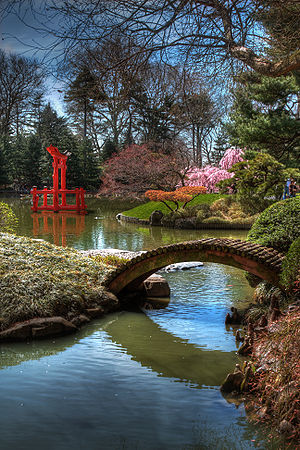 BBG's Japanese Hill-and-Pond Garden was the first Japanese garden
BBG's Japanese Hill-and-Pond Garden was the first Japanese garden
to be created in an American public garden. It was constructed in 1914 and 1915 at a cost of $13,000, a gift of early BBG benefactor and trustee Alfred T. White, and it first opened to the public in June 1915. Widely considered by numerous landscape architects, to be the masterpiece of its creator, Japanese landscape designer Takeo Shiota
(1881–1943). Shiota was born in a small Japanese village about 40 miles (64.4 km) from Tokyo
, and in his youth spent years traversing Japan on foot to explore its natural landscape
. He emigrated to the United States in 1907.
The garden is a blend of the ancient hill-and-pond style and the more modern stroll-garden style, in which various landscape features are gradually revealed along winding paths. Its 3 acres (1.2 ha) contain hills, a waterfall, a pond, and an island, all artificially constructed. Carefully placed rocks also play leading roles. Among the architectural elements of the garden are wooden bridges, stone lanterns, a viewing pavilion, a torii
or gateway, and a Shinto
shrine. A restoration of the garden in 2000 was recognized with the New York Landmark Conservancy's 2001 Preservation Award.
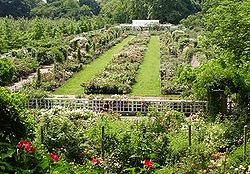 In 1927, Walter V. Cranford, a construction engineer whose firm built many of Brooklyn's subway tunnels, donated $15,000 to BBG for a rose garden. Excavation revealed an old cobblestone road two feet below the surface and tons of glacial rock, which had to be carted away on horse-drawn barges.
In 1927, Walter V. Cranford, a construction engineer whose firm built many of Brooklyn's subway tunnels, donated $15,000 to BBG for a rose garden. Excavation revealed an old cobblestone road two feet below the surface and tons of glacial rock, which had to be carted away on horse-drawn barges.
The Cranford Rose Garden opened in June 1928. It was designed by Harold Caparn, a landscape architect, and Montague Free, the Garden's horticulturist. Many of the original plants are still in the garden today. There are over 5,000 bushes of nearly 1,400 kinds of rose
s, including wild species, old garden roses, hybrid tea roses, grandifloras, floribundas, polyanthas, hybrid perpetuals, climbers, ramblers, and miniature roses.
in Washington, D.C.
paved the way for the construction of BBG's original Shakespeare Garden in 1925. Since moved to a different location in the Garden, this English
cottage garden
exhibits more than 80 plants mentioned in William Shakespeare
's plays and poems. Plant labels give the plants' common or Shakespearean names, their botanical names, relevant quotations, and, in some cases, a graphic representation of the plant.
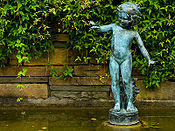 Next to the Shakespeare Garden is the Fragrance Garden, complete with braille
Next to the Shakespeare Garden is the Fragrance Garden, complete with braille
information signs for visitors with vision disabilities. Created in 1955 by landscape architect Alice Recknagel Ireys, this was the first garden in the country designed for the vision-impaired. All visitors are encouraged to rub the fragrant or pleasingly textured leaves of the plants between their fingers. There are four sections in the garden, each with a theme: (1) plants to touch, (2) plants with scented leaves, (3) plants with fragrant flowers, and (4) kitchen herbs. The garden is wheelchair-accessible, and all planting beds are at an appropriate height for people in wheelchairs. A fountain provides a calming sound and a place to wash one's hands after touching the various plants.
 Other specialty gardens at BBG include: the Discovery Garden, designed for young children; the Herb Garden; the Lily Pool Terrace, which includes two large display pools and annual and perennial borders; the Native Flora garden, the first of its kind in North America; the Osborne Garden, a 3 acres (1.2 ha), Italian-style garden, and the Rock Garden, built around 18 boulders left behind by the glacier during the Ice Age
Other specialty gardens at BBG include: the Discovery Garden, designed for young children; the Herb Garden; the Lily Pool Terrace, which includes two large display pools and annual and perennial borders; the Native Flora garden, the first of its kind in North America; the Osborne Garden, a 3 acres (1.2 ha), Italian-style garden, and the Rock Garden, built around 18 boulders left behind by the glacier during the Ice Age
. A Celebrity Path honors famous Brooklynites past and present, such as Barbra Streisand
, Woody Allen
, and Walt Whitman
, with a trail of engraved paving stones.
The Plant Family Collection, which takes about a third of BBG's total area, includes plants and trees arranged by family to show their evolutionary progression from most primitive to most recently evolved. Although recent studies of plant genetics have changed classification of individual plants, the groupings are still an excellent introduction to the many different plant families and their constituent species.
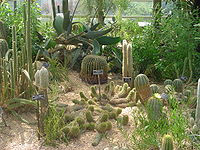 The Steinhardt Conservatory houses BBG's extensive indoor plant collection in three climate-controlled pavilions for tropical, warm temperate, and desert floras. Also located here are: the C.V. Starr Bonsai Museum, one of the oldest collections of dwarfed, potted trees in the country; an art gallery for changing art exhibitions; the Robert W. Wilson Aquatic House, with its collections of tropical water plants, insect-eating plants, and orchids; and the Stephen K-M. Tim Trail of Evolution, which traces the history of plant evolution and the effects of climate change over 3½ billion years.
The Steinhardt Conservatory houses BBG's extensive indoor plant collection in three climate-controlled pavilions for tropical, warm temperate, and desert floras. Also located here are: the C.V. Starr Bonsai Museum, one of the oldest collections of dwarfed, potted trees in the country; an art gallery for changing art exhibitions; the Robert W. Wilson Aquatic House, with its collections of tropical water plants, insect-eating plants, and orchids; and the Stephen K-M. Tim Trail of Evolution, which traces the history of plant evolution and the effects of climate change over 3½ billion years.
Scientists at Brooklyn Botanic Garden are undertaking a comprehensive study of the plants of metropolitan New York, called the New York Metropolitan Flora project, or NYMF. The purpose of NYMF is to catalog and describe all vascular plants growing in the region.
The BBG Herbarium houses about 300,000 specimens of preserved plants, particularly plants from the New York metropolitan area. These specimens, some from as early as 1818, create a historical record and aid BBG scientists in tracking species, analyzing the spread of invasive plants, and modeling changes in the metro region's vegetation. There are also holdings from the western United States, the Galapagos Islands, Bolivia, and Mauritius.
BBG scientists are conducting research on the evolution and classification of plants, a field called plant systematics. BBG's three Ph.D. scientists are experts in several plant families, including Scrophulariaceae
, Cyperaceae
, Juncaceae
, and Anacardiaceae
and have contributed several treatments to the ongoing Flora of North America project.
 The Garden's Education department runs a full range of adult and children's classes and events, and also educates thousands of school and camp groups throughout the year.
The Garden's Education department runs a full range of adult and children's classes and events, and also educates thousands of school and camp groups throughout the year.
Brooklyn Botanic Garden is a founding partner of the Brooklyn Academy of Science and the Environment (BASE), a small public high school dedicated to science, environmental studies, and urban ecology that was launched in 2003. The school is operated by a partnership between BBG, Prospect Park Alliance, and the New York City Department of Education
. BASE graduated its first class in 2007.
BBG's Garden Apprentice Program (GAP) provides internships for students in grades 8 through 12 in gardening, science education, and environmental issues. The program offers students training and volunteer placements with increasing levels of responsibility for up to four years.
Project Green Reach
is a science-focused school outreach program which annually reaches nearly 2,500 students and teachers in public and nonpublic schools in underserved neighborhoods.
The annual Greenest Block in Brooklyn contest encourages neighborhood beautification by offering classes in planting window boxes, planters, and tree pits and recognizing outstanding efforts.
The Urban Composting Project, supported by the New York City Department of Sanitation
, offers composting assistance and resources to community gardens and institutions and information on composting in residential backyards to individuals.
alternatives.
BBG's website, bbg.org, showcases the Garden and its programs and offers information for the home gardener in popular features such as Garden Botany and Environmental Gardening. New features are added every week, including seasonal interactive guides such as "ID Your Holiday Tree" and "Cherry Watch," and online resources like the Metropolitan Plant Encyclopedia. BBG's collection of historic photographs and lantern slides was recently made available online. The website was one of the first to be fully compliant with federal laws requiring information technology to be equally accessible to the disabled.
BBG has about 165 full-time and 90 part-time employees along with 600 volunteers. Its annual operating budget is $16.2 million.
Botanical garden
A botanical garden The terms botanic and botanical, and garden or gardens are used more-or-less interchangeably, although the word botanic is generally reserved for the earlier, more traditional gardens. is a well-tended area displaying a wide range of plants labelled with their botanical names...
in the borough
Borough (New York City)
New York City, one of the largest cities in the world, is composed of five boroughs. Each borough now has the same boundaries as the county it is in. County governments were dissolved when the city consolidated in 1898, along with all city, town, and village governments within each county...
of Brooklyn
Brooklyn
Brooklyn is the most populous of New York City's five boroughs, with nearly 2.6 million residents, and the second-largest in area. Since 1896, Brooklyn has had the same boundaries as Kings County, which is now the most populous county in New York State and the second-most densely populated...
in New York City
New York City
New York is the most populous city in the United States and the center of the New York Metropolitan Area, one of the most populous metropolitan areas in the world. New York exerts a significant impact upon global commerce, finance, media, art, fashion, research, technology, education, and...
. Located near the Prospect Heights
Prospect Heights, Brooklyn
Prospect Heights is a neighborhood in the northwest of the New York City borough of Brooklyn. The traditional boundaries are Flatbush Avenue to the west, Atlantic Avenue to the north, Eastern Parkway to the south, and Washington Avenue to the east...
, Crown Heights
Crown Heights, Brooklyn
Crown Heights is a neighborhood in the central portion of the New York City borough of Brooklyn. The main thoroughfare through this neighborhood is Eastern Parkway, a tree-lined boulevard designed by Frederick Law Olmsted extending two miles east-west.Originally, the area was known as Crow Hill....
, and Park Slope
Park Slope, Brooklyn
Park Slope is a neighborhood in western Brooklyn, New York City's most populous borough. Park Slope is roughly bounded by Prospect Park West to the east, Fourth Avenue to the west, Flatbush Avenue to the north, and 15th Street to the south, though other definitions are sometimes offered. Generally...
neighborhoods, the 52 acres (21 ha) garden includes a number of specialty "gardens within the Garden," plant collections, and the Steinhardt Conservatory, which houses the C.V. Starr Bonsai Museum, three climate-themed plant pavilions, a white cast-iron
Cast iron
Cast iron is derived from pig iron, and while it usually refers to gray iron, it also identifies a large group of ferrous alloys which solidify with a eutectic. The color of a fractured surface can be used to identify an alloy. White cast iron is named after its white surface when fractured, due...
and glass aquatic plant
Aquatic plant
Aquatic plants are plants that have adapted to living in aquatic environments. They are also referred to as hydrophytes or aquatic macrophytes. These plants require special adaptations for living submerged in water, or at the water's surface. Aquatic plants can only grow in water or in soil that is...
house, and an art gallery
Art gallery
An art gallery or art museum is a building or space for the exhibition of art, usually visual art.Museums can be public or private, but what distinguishes a museum is the ownership of a collection...
. Founded in 1910, the Garden holds over 10,000 taxa of plants and each year welcomes over 900,000 visitors from around the world.
Cherry trees

Cherry
The cherry is the fruit of many plants of the genus Prunus, and is a fleshy stone fruit. The cherry fruits of commerce are usually obtained from a limited number of species, including especially cultivars of the wild cherry, Prunus avium....
trees of forty-two Asia
Asia
Asia is the world's largest and most populous continent, located primarily in the eastern and northern hemispheres. It covers 8.7% of the Earth's total surface area and with approximately 3.879 billion people, it hosts 60% of the world's current human population...
n species and cultivated varieties, making it one of the foremost cherry-viewing sites outside of Japan
Japan
Japan is an island nation in East Asia. Located in the Pacific Ocean, it lies to the east of the Sea of Japan, China, North Korea, South Korea and Russia, stretching from the Sea of Okhotsk in the north to the East China Sea and Taiwan in the south...
. The first cherries were planted at the garden after World War I, a gift from the Japanese government. Each spring at BBG, when the trees are in bloom, a month-long cherry blossom viewing festival called Hanami
Hanami
is the Japanese traditional custom of enjoying the beauty of flowers, "flower" in this case almost always meaning cherry blossoms or ume blossoms. From the end of March to early May, sakura bloom all over Japan, and around the first of February on the island of Okinawa...
is held, culminating in a weekend celebration called Sakura Matsuri. Cherry trees are found on the Cherry Esplanade and Cherry Walk, in the Japanese Hill-and-Pond Garden, and in many other locations in the Garden. Depending on weather conditions, the Asian flowering cherries bloom from late March or early April to mid-May. The many different species bloom at slightly different times, and the sequence is tracked online at Cherry Watch, on the BBG website.
The Japanese Hill-and-Pond Garden

Japanese garden
, that is, gardens in traditional Japanese style, can be found at private homes, in neighborhood or city parks, and at historical landmarks such as Buddhist temples, Shinto shrines and old castles....
to be created in an American public garden. It was constructed in 1914 and 1915 at a cost of $13,000, a gift of early BBG benefactor and trustee Alfred T. White, and it first opened to the public in June 1915. Widely considered by numerous landscape architects, to be the masterpiece of its creator, Japanese landscape designer Takeo Shiota
Takeo Shiota
Takeo Shiota was a Japanese-American landscape architect, best known for his design of the Japanese Hill-and-Pond Garden at the Brooklyn Botanic Garden....
(1881–1943). Shiota was born in a small Japanese village about 40 miles (64.4 km) from Tokyo
Tokyo
, ; officially , is one of the 47 prefectures of Japan. Tokyo is the capital of Japan, the center of the Greater Tokyo Area, and the largest metropolitan area of Japan. It is the seat of the Japanese government and the Imperial Palace, and the home of the Japanese Imperial Family...
, and in his youth spent years traversing Japan on foot to explore its natural landscape
Natural landscape
A natural landscape is a landscape that is unaffected by human activity. A natural landscape is intact when all living and nonliving elements are free to move and change. The nonliving elements distinguish a natural landscape from a wilderness. A wilderness includes areas within which natural...
. He emigrated to the United States in 1907.
The garden is a blend of the ancient hill-and-pond style and the more modern stroll-garden style, in which various landscape features are gradually revealed along winding paths. Its 3 acres (1.2 ha) contain hills, a waterfall, a pond, and an island, all artificially constructed. Carefully placed rocks also play leading roles. Among the architectural elements of the garden are wooden bridges, stone lanterns, a viewing pavilion, a torii
Torii
A is a traditional Japanese gate most commonly found at the entrance of or within a Shinto shrine, where it symbolically marks the transition from the profane to the sacred...
or gateway, and a Shinto
Shinto
or Shintoism, also kami-no-michi, is the indigenous spirituality of Japan and the Japanese people. It is a set of practices, to be carried out diligently, to establish a connection between present day Japan and its ancient past. Shinto practices were first recorded and codified in the written...
shrine. A restoration of the garden in 2000 was recognized with the New York Landmark Conservancy's 2001 Preservation Award.
The Cranford Rose Garden

The Cranford Rose Garden opened in June 1928. It was designed by Harold Caparn, a landscape architect, and Montague Free, the Garden's horticulturist. Many of the original plants are still in the garden today. There are over 5,000 bushes of nearly 1,400 kinds of rose
Rose
A rose is a woody perennial of the genus Rosa, within the family Rosaceae. There are over 100 species. They form a group of erect shrubs, and climbing or trailing plants, with stems that are often armed with sharp prickles. Flowers are large and showy, in colours ranging from white through yellows...
s, including wild species, old garden roses, hybrid tea roses, grandifloras, floribundas, polyanthas, hybrid perpetuals, climbers, ramblers, and miniature roses.
The Shakespeare Garden
A donation from Henry C. Folger, founder of the Folger Shakespeare LibraryFolger Shakespeare Library
The Folger Shakespeare Library is an independent research library on Capitol Hill in Washington, D.C., in the United States. It has the world's largest collection of the printed works of William Shakespeare, and is a primary repository for rare materials from the early modern period...
in Washington, D.C.
Washington, D.C.
Washington, D.C., formally the District of Columbia and commonly referred to as Washington, "the District", or simply D.C., is the capital of the United States. On July 16, 1790, the United States Congress approved the creation of a permanent national capital as permitted by the U.S. Constitution....
paved the way for the construction of BBG's original Shakespeare Garden in 1925. Since moved to a different location in the Garden, this English
England
England is a country that is part of the United Kingdom. It shares land borders with Scotland to the north and Wales to the west; the Irish Sea is to the north west, the Celtic Sea to the south west, with the North Sea to the east and the English Channel to the south separating it from continental...
cottage garden
Cottage garden
The cottage garden is a distinct style of garden that uses an informal design, traditional materials, dense plantings, and a mixture of ornamental and edible plants. English in origin, the cottage garden depends on grace and charm rather than grandeur and formal structure...
exhibits more than 80 plants mentioned in William Shakespeare
William Shakespeare
William Shakespeare was an English poet and playwright, widely regarded as the greatest writer in the English language and the world's pre-eminent dramatist. He is often called England's national poet and the "Bard of Avon"...
's plays and poems. Plant labels give the plants' common or Shakespearean names, their botanical names, relevant quotations, and, in some cases, a graphic representation of the plant.
The Alice Recknagel Ireys Fragrance Garden

Braille
The Braille system is a method that is widely used by blind people to read and write, and was the first digital form of writing.Braille was devised in 1825 by Louis Braille, a blind Frenchman. Each Braille character, or cell, is made up of six dot positions, arranged in a rectangle containing two...
information signs for visitors with vision disabilities. Created in 1955 by landscape architect Alice Recknagel Ireys, this was the first garden in the country designed for the vision-impaired. All visitors are encouraged to rub the fragrant or pleasingly textured leaves of the plants between their fingers. There are four sections in the garden, each with a theme: (1) plants to touch, (2) plants with scented leaves, (3) plants with fragrant flowers, and (4) kitchen herbs. The garden is wheelchair-accessible, and all planting beds are at an appropriate height for people in wheelchairs. A fountain provides a calming sound and a place to wash one's hands after touching the various plants.
The Children's Garden
The BBG Children's Garden is the oldest continually operating children's garden within a botanic garden in the world. It was opened in 1914 under the direction of BBG educator Ellen Eddy Shaw and operates as a community garden for children, with hundreds of children registering each year for plots on the 1 acre (0.404686 ha) site. The BBG Children's Garden has served as a model for similar gardens around the world.Other gardens

Ice age
An ice age or, more precisely, glacial age, is a generic geological period of long-term reduction in the temperature of the Earth's surface and atmosphere, resulting in the presence or expansion of continental ice sheets, polar ice sheets and alpine glaciers...
. A Celebrity Path honors famous Brooklynites past and present, such as Barbra Streisand
Barbra Streisand
Barbra Joan Streisand is an American singer, actress, film producer and director. She has won two Academy Awards, eight Grammy Awards, four Emmy Awards, a Special Tony Award, an American Film Institute award, a Peabody Award, and is one of the few entertainers who have won an Oscar, Emmy, Grammy,...
, Woody Allen
Woody Allen
Woody Allen is an American screenwriter, director, actor, comedian, jazz musician, author, and playwright. Allen's films draw heavily on literature, sexuality, philosophy, psychology, Jewish identity, and the history of cinema...
, and Walt Whitman
Walt Whitman
Walter "Walt" Whitman was an American poet, essayist and journalist. A humanist, he was a part of the transition between transcendentalism and realism, incorporating both views in his works. Whitman is among the most influential poets in the American canon, often called the father of free verse...
, with a trail of engraved paving stones.
The Plant Family Collection, which takes about a third of BBG's total area, includes plants and trees arranged by family to show their evolutionary progression from most primitive to most recently evolved. Although recent studies of plant genetics have changed classification of individual plants, the groupings are still an excellent introduction to the many different plant families and their constituent species.

Plant science and research
Less apparent to the casual visitor are BBG's diverse programs in scientific research, youth education, and community horticulture.Scientists at Brooklyn Botanic Garden are undertaking a comprehensive study of the plants of metropolitan New York, called the New York Metropolitan Flora project, or NYMF. The purpose of NYMF is to catalog and describe all vascular plants growing in the region.
The BBG Herbarium houses about 300,000 specimens of preserved plants, particularly plants from the New York metropolitan area. These specimens, some from as early as 1818, create a historical record and aid BBG scientists in tracking species, analyzing the spread of invasive plants, and modeling changes in the metro region's vegetation. There are also holdings from the western United States, the Galapagos Islands, Bolivia, and Mauritius.
BBG scientists are conducting research on the evolution and classification of plants, a field called plant systematics. BBG's three Ph.D. scientists are experts in several plant families, including Scrophulariaceae
Scrophulariaceae
Scrophulariaceae, the figwort family, are a family of flowering plants. The plants are annual or perennial herbs with flowers with bilateral or rarely radial symmetry. Members of the Scrophulariaceae have a cosmopolitan distribution, with the majority found in temperate areas, including...
, Cyperaceae
Cyperaceae
Cyperaceae are a family of monocotyledonous graminoid flowering plants known as sedges, which superficially resemble grasses or rushes. The family is large, with some 5,500 species described in about 109 genera. These species are widely distributed, with the centers of diversity for the group...
, Juncaceae
Juncaceae
Juncaceae, the rush family, are a monocotyledonous family of flowering plants. There are eight genera and about 400 species. Members of the Juncaceae are slow-growing, rhizomatous, herbaceous plants, and they may superficially resemble grasses. They often grow on infertile soils in a wide range...
, and Anacardiaceae
Anacardiaceae
Anacardiaceae are a family of flowering plants bearing fruits that are drupes and in some cases producing urushiol, an irritant. Anacardiaceae include numerous genera with several of economic importance. Notable plants in this family include cashew , mango, poison ivy, sumac, smoke tree, and marula...
and have contributed several treatments to the ongoing Flora of North America project.
Education programs

Brooklyn Botanic Garden is a founding partner of the Brooklyn Academy of Science and the Environment (BASE), a small public high school dedicated to science, environmental studies, and urban ecology that was launched in 2003. The school is operated by a partnership between BBG, Prospect Park Alliance, and the New York City Department of Education
New York City Department of Education
The New York City Department of Education is the branch of municipal government in New York City that manages the city's public school system. It is the largest school system in the United States, with over 1.1 million students taught in more than 1,700 separate schools...
. BASE graduated its first class in 2007.
BBG's Garden Apprentice Program (GAP) provides internships for students in grades 8 through 12 in gardening, science education, and environmental issues. The program offers students training and volunteer placements with increasing levels of responsibility for up to four years.
Project Green Reach
Project Green Reach
Project Green Reach is a science-focused school outreach program for teachers and students that is designed specifically to work with Brooklyn's Title I schools. It is an entity within the education department at the Brooklyn Botanic Garden, which is a world-renowned botanical garden located in...
is a science-focused school outreach program which annually reaches nearly 2,500 students and teachers in public and nonpublic schools in underserved neighborhoods.
Community horticulture
GreenBridge, the community horticulture program of the Brooklyn Botanic Garden, shares BBG's knowledge and resources with Brooklyn neighborhoods by offering residential and commercial gardening programs to block associations, community gardens, community centers, and other groups.The annual Greenest Block in Brooklyn contest encourages neighborhood beautification by offering classes in planting window boxes, planters, and tree pits and recognizing outstanding efforts.
The Urban Composting Project, supported by the New York City Department of Sanitation
New York City Department of Sanitation
The New York City Department of Sanitation, or DSNY, is a uniformed force of unionized sanitation workers in New York City. Their responsibilities include garbage collection, recycling collection, street cleaning, and snow removal...
, offers composting assistance and resources to community gardens and institutions and information on composting in residential backyards to individuals.
Garden publications
BBG has been producing publications since 1945, when it launched America's first series of popular gardening handbooks. Today, the Brooklyn Botanic Garden All-Region Guides continue to provide home gardeners with practical information on subjects such as garden design, great plants, and gardening techniques. A recent title, Native Alternatives to Invasive Plants, uses BBG's extensive knowledge of invasive plants to educate gardeners about both the problem of invasive species and garden-worthy native plantNative plant
Native plant is a term to describe plants endemic or naturalized to a given area in geologic time.This includes plants that have developed, occur naturally, or existed for many years in an area...
alternatives.
BBG's website, bbg.org, showcases the Garden and its programs and offers information for the home gardener in popular features such as Garden Botany and Environmental Gardening. New features are added every week, including seasonal interactive guides such as "ID Your Holiday Tree" and "Cherry Watch," and online resources like the Metropolitan Plant Encyclopedia. BBG's collection of historic photographs and lantern slides was recently made available online. The website was one of the first to be fully compliant with federal laws requiring information technology to be equally accessible to the disabled.
Visitor information and gardening resources
BBG has two gift shops, a Visitor Center, and a Gardener's Resource Center which provides reference services to home gardeners, staff, and the professional horticultural community. The Visitor Center and Gardener's Resource Center are both located in the McKim, Mead and White Administration Building. During the spring and summer, an outdoor cafe provides a variety of refreshments and meals. The Palm House, a Beaux Arts-style conservatory, is a wedding and events venue offering catering for up to 300 guests. Group tours are also available.BBG has about 165 full-time and 90 part-time employees along with 600 volunteers. Its annual operating budget is $16.2 million.
See also
- List of botanical gardens in the United States
- List of museums and cultural institutions in New York City
External links
- Brooklyn Botanic Garden Website
- BBG Historic Image Collection (many images are in public domainPublic domainWorks are in the public domain if the intellectual property rights have expired, if the intellectual property rights are forfeited, or if they are not covered by intellectual property rights at all...
) - Review of Brooklyn Botanic Garden
- Google map of the BBG
- Numerous high-resolution photographs of the Garden

